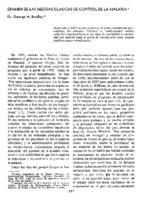Examen de las medidas clásicas de control de la malaria
Date
s.d.1969
Author
Metadata
Show full item recordAbstract
Through long experience and investigations, it was established that the mosquito species chiefly responsible for spread of malaria in the U.S.A. area Anopheles quadrimaculatus east of the Rocky Mountains and A. freeborni west of the Rockies. In the pre-DDT days, operations to control malaria were based on a knowledge of the biology of these vector species Essentially, the early methods included: 1) Filling or draining to get rid of Anopheles breeding places (draining was generally the more practical and more economical); 2) Larviciding with contact poisons (e.g., oil) or stomach poisons (e.g., paris green), generally employed as a supplement to or during the development of a drainage program; 3) Screening and mosquito-proofing of dwellings; 4) Fluctuations of the water levels in artificial impoundments; 5) Killing of adult mosquitoes with pyrethrum sprays or by swatting; it is worthy of note that sales of pyrethrum sprays for household use increased some 20-fold in the 10 years just preceding the introduction of DDT, i.e., at the time when malaria in the country began its marked regression Less valuable materials and methods, but sometimes used, nonetheless, were: mosquito nets or "bars," repellents, traps, and various naturalistic methods. The latter included the erection of plant barriers; use of drugs such as sulphus to modify perspiration odor and thus repel mosquitoes; use of natural ...(AU)
Translated title
Review of classical malaria control measures
Subject
Collections
Related items
Showing items related by title, author, creator and subject.
-
Morrow, Meredith G; Johnson, Richard N; Polanco, Jorge; Claborn, David M (2010)
-
Pan American Health Organization (PAHOOPSOPASUnited StatesWashington, D.C., 2018)
-
Torres Goitia, Rene (s.d.)




